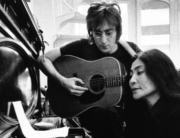I Am The Blues is a blues fan’s ultimate road trip through the Mississippi Delta and Louisiana bayous to see and hear the oldest living progenitors singing and playing in their home towns. Director Daniel Cross is a Canadian documentarian, but he was given bona fides to casually meet with the area’s elder musicians by Ira “Dr. Ike” Padnos of the Ponderosa Stomp Foundation, a preeminent roots music promoter.
In a reverse of the Great Migration north and west away from Jim Crowe, where many found success during the blues revival as sidemen (they all seem to have played with B.B. King), they returned South for family and old friends to jam with. (Their homes and hangouts are now honored on Mississippi’s Blues Trail.) Cross reveals less widely known octogenarian and nonagenarian national treasures, several just before they passed on, accompanied by interviews, performances, impromptu playing, travelogue images of endless fields and Spanish moss, and a stop at a rousing church service,
The irrepressible guide, and the most well-known musician here, is road warrior, Blues Hall of Famer, and raconteur Bobby Rush. At 83, the “King of the Chitlin’ Circuit” was just awarded his first Grammy Award, in his 56th year of recording, for traditional blues album. While driving the highways from his home in Jackson, he makes up a song and adds to his 300-plus song credits, and recalls his childhood picking cotton (and spying on the white buyers so his father could try to negotiate a better price). The freedom he thought he’d find around Chicago was stymied by humiliating de facto segregation and cheating promoters reneging on pay for his full band (a problem he’s still negotiating).
The film’s central touchstone is the Blue Front Café in Bentonia, Yazoo County, presided over by young 70-year-old Jimmy “Duck” Holmes and his guitar. Opened by his parents in 1948 in the hometown of Skip James (one of the bluesmen whose rediscovery was documented in Samuel Pollard’s Two Trains Runnin’ ), it is the oldest surviving juke joint in the state. Among the players, L.C. Ulmer (1928–2016) sings the first song he ever learned. In Louisiana for a big get-together, Barbara Lynn, only 75, is a highlight. While her “You’ll Lose a Good Thing” was a 1962 R & B chart topper and her “Oh Baby (We’ve Got a Good Thing Going)” was covered by the Rolling Stones, she blazingly demonstrates she’s a smokin’ electric blues guitar player; the women in the audience are big fans.
Cinematographer John Price hones in on strumming fingers and stomping feet to closely reveal how these folks can still work it. His vérité style intimately captures the warm teasing and give and take among these dozen old friends and their local admirers, especially around eating at a crawfish boil and a North Mississippi hill country barbeque. Part Alan Lomax, part Les Blank’s style, the history flows naturally, from the concert posters on the walls and the conversations filmed over three years.
Reverend John Wilkins leads a blues service and insists it’s now a misnomer for churches to brand the blues “the devil’s music.” Despite the blues revival that made possible these musicians’ performing careers, they all bemoan the future of blues in the Deep South. But there’s hope in the frequent shots of a boy watching them play and taking hold of a guitar–the grandson of Duck Holmes. The credits close with a plea: “Support blues and blues musicians–buy blues music!”







Leave A Comment